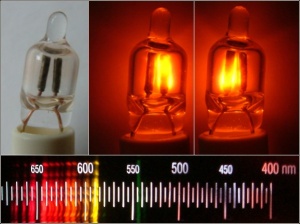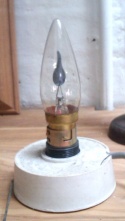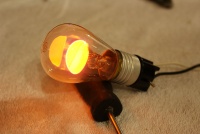Neon
Neon indicator lamp
These tiny lights are used as indicators. They've been replaced by LEDs in modern electronics, but are still used for mains power indication.
They're also used to enable finding light switches in the dark. For this they're wired from switched live to live, so they light only when the main light is off.
Types
Indicator neons come in these types of package:
- just the bare glass neon - shown above
- bare neon plus resistor, shrink wrapped
- in small round housing for panel mounting (with fixing nut)
- in rectangular housing about 13x28mm (clip-in) - shown on the right
- 4 neons with resistors built into a plastic square ring that mounts behind a light switch faceplate
- MK gridswitch part
All of these except the first normally come with built in resistor.
Mounting
Ways to mount bare neon indicators:
- Drill a tiny hole, and poke the glass tip of the neon into it
- Fit a translucent plastic spacer behind the lightswitch, with built in neons and resistor
- Fix a neon in a plastic housing into a suitable round or rectangular hole with a nut. These come in the usual neon colours, red, orange, yellow and sometimes others.
- In some situations its sufficient to simply mount the neon behind a white plastic front, which then glows. Light output is low this way, and only suited to dim locations.
Round housed neons go through a drilled panel hole, fixed with a nut.
Rectangular housed neons sit in a rectangular hole. Making these holes without a suitable punch is excessively slow. The housing just presses in place. To remove one, compress the 2 plastic fingers that hold it in place. Light-up (neon) rocker switches in this format are also widely available.
Light-up switch rings simply sit behind the switch faceplate, and are held by the faceplate screws.
Gridswitch parts only fit the MK gridswitch system.
Resistor
Indicator neons must be operated in series with a suitable resistor, usually 220k for 1mA 240v operation. Failure to do so results in rapid failure. Most neon indicators have this built in, but neons without resistor are also available. A 240v rated neon means a resistor is built in.
If providing your own resistor, it needs to be 400v rated, and typical 0.3w carbon film resistors are 200v rated. Use 2x 120k 200v resistors in series.
Neons do come in other current ratings, but the classic 1mA NE-2 lamp is most common. If the light source moves about unstably in the lamp, its running below rated current.
Neon flickering candle lamp
Small imitation candle bulbs, the light sources moves about as it operates. Light output is minimal, and the effect not very realistic.
They work by underrunning the neon so there isn't enough current to generate a discharge over the whole cathode, and convection, photons, and other random events cause the discharge area to move over the electrode.
Neon screwdriver
An unsafe voltage detector. See Neon screwdriver
Sign lighting
Neon gas filled shaped tubes have been used in advertising since the 1920s, coloured to produce red, yellow & orange light. Modern coloured 'neon' tubing uses other gases too and is mostly fluorescent.
Connection
Most neons are simply connected from the switched live to neutral.
Neon switch locator plates that light when the switch is off are usually connected from live to switched live. This works fine with with filament, mains halogen & 12v halogen, and iron ballasted fluorescent. Connecting from live to switched live doesn't always work ok with CFL and electronic ballasted fluorescent, it sometimes causes occasional flashing.
Connecting switch locator neons from the switch's unused switched live connection to neutral works with all lighting types - like so:
o------- switched live to light fitting
L ------o--->
o---------(neon)--+
switch |
|
N -----------------------------+
History
Neons have had a variety of uses that are now obsolete. The main ones are below.
Neon lamp
Neon lightbulbs of a few watts were once used for low level lighting. The light is yellow-orange. Sometimes the electrodes were shaped into novelty designs. They were even used as part of TV picture displays in 1920s mechanically scanned tvs. They fell out of favour in the 1930s.
Neon tuning indicator
A column shaped neon used in some pre-war radios. The height of the glow is proportional to the current through them.
Dekatron
A dekatron was a glass device producing an orange dot in any of 10 positions, indicating 0-9. Numbers were marked on the case around the dekatron, and parallax errors sometimes caused misreads. They were superseded by the much more user friendly nixies.
Nixie
As shown on the right, these display a single digit from 0-9. Each digit has its own shaped wire electrode. Though long obsolete, NOS nixies are still available and used in diy clock projects.
Neon regulator
Indicator neons were once used as voltage regulators at about 90v. 3 terminal neons (NE-77) were once used as voltage limiters in some old dial telephones. NE-77s are occasionally used in modern appliances as dual circuit indicators, eg in electric blankets.
Electronic components
Neons' bistable nature has even seen them used as electronic switching components, eg in TVs and organs. Their deterioration over time caused unreliability.
Light colour
The orange light is a mixture of red, orange & yellow light. Colour filters are often added externally to give any of these colours, or to improve on/off contrast with orange. Green, blue and white neons contain other gases, and fluoresce.
Neon filled neons with a green plastic cover also exist, but don't actually produce green light. The result is a muddy yellow.
Energy efficiency
Neons are several times the efficacy of filament lamps. However the power levels used are so miniscule as to be of no consequence. Neon indicators don't warm up in use.
Life expectancy
Neon indicators last years, but not always for the life of the product they're in. They last best in situations where they're not on all the time.
Light output deteriorates a lot over time. The usual failure mode is blackening of the glass bulb due to electrode spluttering. The neon pictured above is so blackened it emits no light.
Life expectancy to the power of 3.5 is proportional to current, so life can be much increased by reducing run current. A 10% drop in current gives a 44% gain in lifetime.
Neon v LED
Neon's one advantage is running at mains voltage, making a neon much easier to use to indicate mains. LEDs run at low voltage.
As indicators, LEDs have the advantages of longer life, a wider range of colours and greater light output.
As low level lighting, LEDs have all the advantages except for needing a low voltage supply. Lighting LEDs can be longer or shorter lived than neons.
More info
Most neon lamps contain neon and 0.5% argon. These strike at about 90v and run at around 60v (some do run higher). Higher efficiency neons once used for lighting use pure neon gas for better output - but their higher strike voltage of around 120v precludes their use on 110v mains.
Green and blue also strike at higher voltages, and don't run on 110v.
Failed sodium lamps can be used as giant neon bulbs at suitably low current.









